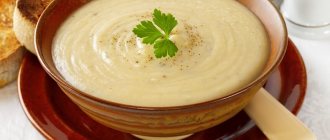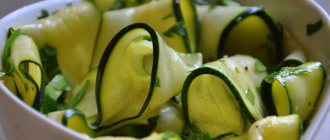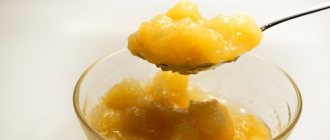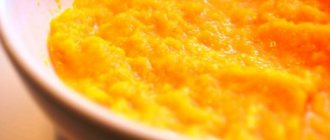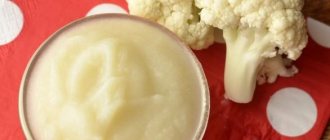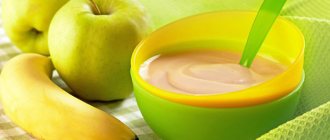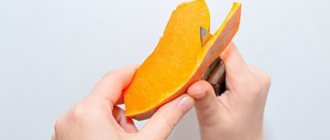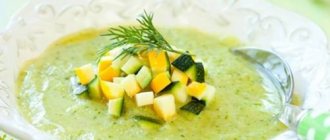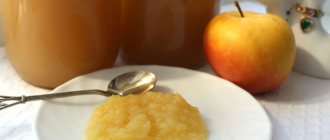Cauliflower puree can be given to infants as complementary foods as early as 6 months, for bottle-fed or mixed-fed babies - at 4 months. Cauliflower is a storehouse of vitamins, minerals and beneficial acids. At the same time, it is safe for children, as it rarely causes allergies and has a gentle effect on digestion. In this article we will learn the beneficial properties of the vegetable and consider a recipe for cauliflower puree for babies.
Benefits of cauliflower
Pediatricians advise including foods that do not cause allergies and are easily digestible in the first complementary foods for infants. The composition of cauliflower is ideal for little ones. Children eat vegetables with pleasure, and even an inexperienced housewife can prepare mashed soup from cauliflower or broccoli.
- All varieties of cabbage are rich in vitamin C, which strengthens the immune system. Cauliflower contains twice as much of this vitamin as white cabbage.
- Methionine or vitamin U. This component is not synthesized by the body and is found in meat, fish and eggs, which the baby cannot receive with the first complementary foods. Methionine deficiency leads to defects in the development of the central nervous system and growth retardation in children.
- Vitamins B, A, K, D and E are necessary for the absorption of potassium, phosphorus, calcium, iron, iodine and manganese.
- Vegetable protein is easily absorbed by the infant's fragile digestive system.
Unlike white cabbage, cauliflower does not increase gas formation and extremely rarely causes allergies and colic.
Why cauliflower is good for babies:
- The intestinal mucosa develops normally and is populated by healthy microflora.
- Strong bones and muscles are formed.
- Delicate fiber activates digestion and prevents constipation.
- The immune system fights viruses and bacteria.
- Iron deficiency anemia is excluded - this plant contains ten times more iron than eggplant, zucchini or bell pepper.
Cauliflower rarely causes unwanted reactions, but you should not overuse it, so as not to provoke food intolerance, increased acidity and inflammation of the intestinal mucosa.
Preparing puree for the baby
Ingredients for baby food should be selected especially carefully. If possible, use quality fresh cauliflower heads instead of frozen ones.
An ideal specimen will have dense white buds, succulent light green or blue-green leaves, and no dark spots or other blemishes.
Whatever recipe you prefer for preparing cabbage, the fresh fruit must first be disassembled into large shoots, washed with running water, and then divided into smaller inflorescences.
For the first introduction of this vegetable into a child’s diet, you will need only a few of them (approximately 7-10 pieces), since the initial dose of the product for an infant should be no more than 1 tsp. per day. Every day, the amount of complementary foods consumed by the baby in the form of vegetable puree can be increased by only half a spoon.
Let's look at how to prepare a tender and pleasant-tasting cauliflower mass in different ways.
Cooking on a gas or electric stove
Before cooking the vegetable, clean water (bottled for children or from a filter) is poured into a saucepan and brought to a boil. The selected inflorescences should be placed in boiling water, and then cooked until soft - no more than a quarter of an hour. After this, they are thrown into a colander - the excess liquid will completely drain, and the cabbage will cool slightly.
The finished “raw materials” are kneaded with a blender or rubbed through a sieve. Next, cabbage broth, breast milk, the formula you are used to feeding your baby, or warm boiled water are added to the mixture. The density of the resulting puree determines how much liquid you need to take. By gradually diluting the mass, you eventually need to achieve a consistency identical to the thickness of low-fat sour cream.
Cooking in a steamer
Steaming vegetables is preferable to boiling them, because such heat treatment helps retain more nutrients.
The prepared shoots are placed in a bowl with holes and the steaming time is set to 10-15 minutes. Upon completion of the process, the inflorescences are removed from the bowl, kneaded to a homogeneous consistency using one of the methods described above, cooled slightly and, mixed with breast milk (or formula), diluted.
Multicooker recipe
The cabbage is placed on a special grill, the body of the device is closed, and the steam cooking mode is set, which should last 15 minutes. The finished pieces are crushed with a blender or crushed with a spoon through a sieve. The baby puree is brought to a smooth consistency with mother’s milk, formula or boiled water.
When to introduce into complementary foods
The appropriate age for the first complementary feeding is 6 months for infants and 4-4.5 months for artificial babies. The enzyme system of children accustomed to adapted mixtures is ready to accept such food.
How to determine when it’s time to introduce complementary foods:
- The repulsion reflex disappears - the child does not try to spit out unfamiliar food and swallows it.
- The child demands more and more food, and this trend continues for 5-7 days.
- The toddler can eat while sitting, holds his head well and shows interest in foods.
Offer a new food for the first time in the morning or afternoon. Start with half a teaspoon of puree, diluted to the consistency of liquid sour cream, double the portion every day and monitor the baby’s well-being.
Reactions such as red spots, diarrhea, or tummy pain are very rare, but if you notice anything unusual, your baby may be too early to start solids or may be allergic to cauliflower.
Not all children readily accept new foods. If you encounter resistance, set aside the vegetable puree for one feeding and try again. Sometimes it takes three to four days to obtain the child’s consent.
Vegetable oil can be added to vegetable complementary foods after a month and a half. A few drops of unrefined olive, sunflower, corn or flaxseed oil will be enough.
What to cook from cauliflower for a 1 year old child
1. Rice porridge with meat:
Ingredients: Meat - 100 gr. Rice groats - 3 tbsp. Butter - a small piece. Salt - a pinch.
In this version, the porridge is suitable for children from 1 year of age. Children at this age already cope well with grains of rice, but chewing red meat is still a bit difficult, so it is better to twist it. We also do not add any fried ingredients or excess fat to the porridge. For kids, you can also cook sweet porridge with prunes or pumpkin and zucchini from rice. Recipe for rice porridge with meat: 1. Products for porridge: 100-150 gr. fresh meat, 3 tbsp. rice, a piece of butter for dressing and salt. 2. Separate the meat from the films and cut into pieces. The smaller the pieces, the faster they will cook. 3. Boil the meat until cooked. About 1 hour. 4. Rinse the rice. 5. Boil over low heat until cooked. It cooks for about 20 minutes. 6. Twist the finished pieces of meat a couple of times in a meat grinder. 7. Mix boiled rice with twisted meat. Cook everything together for 3 minutes. 8. Season with butter and serve. Bon appetit! Note: You can use whole grain or broken rice for this porridge. If it is more convenient for your child to eat smaller pieces, use broken rice. If your child has a positive attitude towards greens, you can add them to the porridge. For infants, you can prepare a similar dish, only with milk in the form of puree.
How to choose cauliflower
Homemade purees or ready-made food from the store should be of the highest quality. Vegetable complementary foods from trusted manufacturers are guaranteed to be prepared taking into account strict requirements for raw materials and adherence to technology. When purchasing vegetables in a store or market, you cannot say with certainty that they have not been treated with chemicals. If you grow cauliflower and have no doubt about the quality, you can safely use it in baby food.
When choosing inflorescences, pay attention to signs of freshness and quality of the vegetable:
- White or slightly yellowish inflorescences without spots
- Bright green leaves
- Elasticity and dense planting of inflorescences
- No damage
When deciding whether store-bought or homemade purees are better, consider the price-quality-time ratio. Out of season and when you are short on time, it is advisable to stick to baby food in jars.
Criteria for choosing ready-made complementary foods:
- Glass or aluminum packaging
- Information about the age of children for whom the food is intended
- Best before date
- The composition should not contain preservatives, dyes, flavors, or thickeners.
Choose small jars designed for one day - opened puree cannot be stored in the refrigerator for longer.
On a note
- At the stage of introducing the baby's first complementary foods, there is no need to add salt during the cooking process or to the finished mass.
- Cauliflower can be present on the menu of both a six-month and a one-year-old baby. The only difference will be in the serving size.
- With the introduction of new elements into the child’s diet, the puree can be made multicomponent: cabbage is prepared with other vegetables, taking into account the cooking time of each of them.
You can also add oils (butter or vegetable), egg yolk, cream, etc. to the puree. In addition, it is very useful to pamper children with delicious puree soups. So, each new recipe will delight the baby with a richer taste, and the dishes become more satisfying and nutritious.
Recipe for cabbage puree for babies
When feeding infants, it is allowed to use only purified water or breast milk (adapted formula). There are several ways to prepare cauliflower for a child:
In a saucepan
Ingredients:
- 10 cabbage florets
- 50 water, milk or mixture
Preparation:
- Disassemble the inflorescences into small pieces and rinse thoroughly.
- Place in boiling water and cook until soft, about 15 minutes.
- Drain in a colander.
- Grind the cooled cabbage in a blender or rub through a sieve.
- Add water, milk or mixture until it reaches the consistency of kefir.
In a slow cooker
- Place the disassembled inflorescences in a multicooker cup.
- Turn on the “stew” or “steam” mode for 15 minutes.
- Mash and bring with milk or water to the desired consistency.
In a double boiler (for children after 8 months)
Before you prepare puree soup for your baby, he should become familiar with several products.
Ingredients:
- 4-5 tablespoons of water (milk)
- Chicken egg yolk (optional)
- Half a teaspoon of unrefined vegetable oil
- 5 florets cauliflower or broccoli
- A small piece of potato
Preparation:
- Pour water into the steamer cup.
- Install a steaming rack. Place the separated inflorescences and potatoes.
- Cook for 30 minutes.
- Boil an egg.
- Grind vegetables and egg yolk in a blender.
- Add water and oil.
- Stir the soup puree until smooth.
Don’t worry that the finished dish will seem tasteless to your little one without salt. Young children have not yet developed taste buds, and salt will definitely not benefit the baby.
Recipes with cauliflower for babies
Casserole
- Cauliflower – 0.5 kg;
- Milk – 1 glass;
- Eggs – 2 pieces;
- Grated cheese – 100 g;
- Greens and salt to taste.
Prepare and cook the cabbage. Beat the eggs and pour in the milk, stir, add salt if necessary. Pour the resulting mixture over the cabbage, sprinkle cheese on top and bake until golden brown at two hundred degrees. Decorate the finished casserole with chopped herbs. If desired, you can add tomatoes, peeled and cut into small pieces, to the recipe.
Cutlets
- Cauliflower – 0.5 kg;
- Flour – ¼ cup;
- Egg – 1 pc.;
- Chopped parsley – 1 tbsp. spoon.
Boil and chop the cabbage, break the egg, add flour and parsley. Mix well and form into small patties or meatballs. Fry in vegetable oil until tender or steam. These cutlets are good served with buckwheat, pasta or rice, or mashed potatoes.
Vegetable puree soup
- Cauliflower – 250 grams;
- Broccoli – 250 grams;
- Carrots – 1 pc.;
- Potatoes – 2 tubers;
- Greens to taste.
Prepare and boil the vegetables separately, cut and grind in a blender. Add finely chopped greens, pour in the broth after the cabbage and stir. For babies older than eight months, you can add chopped meat or fish to the soup. Products must be prepared separately, since meat and fish broths are not recommended for small children. When cooked, meat and fish release extractive substances that negatively affect digestion.
Vegetable stew with chicken
- Chicken fillet – 100 g;
- Cauliflower – 300 gr;
- Onion – ½ piece;
- Carrots – 1 pc.;
- Zucchini – 1 medium fruit;
- Tomatoes – 2 pieces;
- Green peas – 150 gr.;
- Low-fat sour cream - 4 tablespoons. spoons.
This recipe is suitable for children over one and a half years old. Cook the chicken separately and cut it. Finely chop the onion and carrots and simmer in vegetable oil. Prepare the zucchini and cabbage, peel the tomato, chop and add to the onions and carrots. Simmer until the tomatoes are soft, then add the peas and add sour cream. Mix the ingredients and simmer for another 5-7 minutes. Instead of chicken, you can use beef, rabbit or turkey.
Cauliflower is also good for a nursing mother.
A safe vegetable can be introduced into the diet in the first week of breastfeeding. Read about the benefits of cauliflower during lactation at the link https://vskormi.ru/mama/cvetnaya-kapusta-pri-grudnom-vskarmlivanii/. Subscribe to our VKontakte group
Recipe for Cauliflower Puree with Milk. Calorie, chemical composition and nutritional value.
Nutritional value and chemical composition of “Cauliflower puree with milk.”
The table shows the nutritional content (calories, proteins, fats, carbohydrates, vitamins and minerals) per 100 grams of edible portion.
| Nutrient | Quantity | Norm** | % of the norm in 100 g | % of the norm in 100 kcal | 100% normal |
| Calorie content | 23.6 kcal | 1684 kcal | 1.4% | 5.9% | 7136 g |
| Squirrels | 1.9 g | 76 g | 2.5% | 10.6% | 4000 g |
| Fats | 0.4 g | 56 g | 0.7% | 3% | 14000 g |
| Carbohydrates | 4.1 g | 219 g | 1.9% | 8.1% | 5341 g |
| Alimentary fiber | 1.7 g | 20 g | 8.5% | 36% | 1176 g |
| Water | 93.2 g | 2273 g | 4.1% | 17.4% | 2439 g |
| Ash | 0.4826 g | ~ | |||
| Vitamins | |||||
| Vitamin A, RE | 2.1 mcg | 900 mcg | 0.2% | 0.8% | 42857 g |
| Retinol | 0.001 mg | ~ | |||
| beta carotene | 0.005 mg | 5 mg | 0.1% | 0.4% | 100000 g |
| Lutein + Zeaxanthin | 22.8421 mcg | ~ | |||
| Vitamin B1, thiamine | 0.043 mg | 1.5 mg | 2.9% | 12.3% | 3488 g |
| Vitamin B2, riboflavin | 0.071 mg | 1.8 mg | 3.9% | 16.5% | 2535 g |
| Vitamin B4, choline | 33.98 mg | 500 mg | 6.8% | 28.8% | 1471 g |
| Vitamin B5, pantothenic | 0.15 mg | 5 mg | 3% | 12.7% | 3333 g |
| Vitamin B6, pyridoxine | 0.097 mg | 2 mg | 4.9% | 20.8% | 2062 g |
| Vitamin B9, folates | 47.816 mcg | 400 mcg | 12% | 50.8% | 837 g |
| Vitamin B12, cobalamin | 0.053 mcg | 3 mcg | 1.8% | 7.6% | 5660 g |
| Vitamin C, ascorbic acid | 36.13 mg | 90 mg | 40.1% | 169.9% | 249 g |
| Vitamin D, calciferol | 0.007 mcg | 10 mcg | 0.1% | 0.4% | 142857 g |
| Vitamin E, alpha tocopherol, TE | 0.052 mg | 15 mg | 0.3% | 1.3% | 28846 g |
| Vitamin H, biotin | 0.421 mcg | 50 mcg | 0.8% | 3.4% | 11876 g |
| Vitamin K, phylloquinone | 10.9 mcg | 120 mcg | 9.1% | 38.6% | 1101 g |
| Vitamin RR, NE | 0.4214 mg | 20 mg | 2.1% | 8.9% | 4746 g |
| Niacin | 0.013 mg | ~ | |||
| Macronutrients | |||||
| Potassium, K | 161.42 mg | 2500 mg | 6.5% | 27.5% | 1549 g |
| Calcium, Ca | 32.59 mg | 1000 mg | 3.3% | 14% | 3068 g |
| Magnesium, Mg | 10.82 mg | 400 mg | 2.7% | 11.4% | 3697 g |
| Sodium, Na | 24.38 mg | 1300 mg | 1.9% | 8.1% | 5332 g |
| Sera, S | 3.95 mg | 1000 mg | 0.4% | 1.7% | 25316 g |
| Phosphorus, P | 37.6 mg | 800 mg | 4.7% | 19.9% | 2128 g |
| Chlorine, Cl | 14.66 mg | 2300 mg | 0.6% | 2.5% | 15689 g |
| Microelements | |||||
| Aluminium, Al | 6.6 mcg | ~ | |||
| Iron, Fe | 0.411 mg | 18 mg | 2.3% | 9.7% | 4380 g |
| Yod, I | 1.18 mcg | 150 mcg | 0.8% | 3.4% | 12712 g |
| Cobalt, Co | 0.105 mcg | 10 mcg | 1.1% | 4.7% | 9524 g |
| Manganese, Mn | 0.1462 mg | 2 mg | 7.3% | 30.9% | 1368 g |
| Copper, Cu | 24.5 mcg | 1000 mcg | 2.5% | 10.6% | 4082 g |
| Molybdenum, Mo | 0.658 mcg | 70 mcg | 0.9% | 3.8% | 10638 g |
| Tin, Sn | 1.71 mcg | ~ | |||
| Selenium, Se | 0.853 mcg | 55 mcg | 1.6% | 6.8% | 6448 g |
| Strontium, Sr | 2.24 mcg | ~ | |||
| Fluorine, F | 15.79 mcg | 4000 mcg | 0.4% | 1.7% | 25332 g |
| Chromium, Cr | 0.26 mcg | 50 mcg | 0.5% | 2.1% | 19231 g |
| Zinc, Zn | 0.1779 mg | 12 mg | 1.5% | 6.4% | 6745 g |
| Digestible carbohydrates | |||||
| Mono- and disaccharides (sugars) | 2.3 g | max 100 g | |||
| Essential amino acids | |||||
| Arginine* | 0.0715 g | ~ | |||
| Valin | 0.0744 g | ~ | |||
| Histidine* | 0.0302 g | ~ | |||
| Isoleucine | 0.0567 g | ~ | |||
| Leucine | 0.0869 g | ~ | |||
| Lysine | 0.0796 g | ~ | |||
| Methionine | 0.0206 g | ~ | |||
| Threonine | 0.0538 g | ~ | |||
| Tryptophan | 0.0192 g | ~ | |||
| Phenylalanine | 0.0531 g | ~ | |||
| Nonessential amino acids | |||||
| Alanin | 0.0781 g | ~ | |||
| Aspartic acid | 0.1739 g | ~ | |||
| Glycine | 0.0479 g | ~ | |||
| Glutamic acid | 0.1975 g | ~ | |||
| Proline | 0.0641 g | ~ | |||
| Serin | 0.0774 g | ~ | |||
| Tyrosine | 0.0324 g | ~ | |||
| Cysteine | 0.0169 g | ~ | |||
| Sterols (sterols) | |||||
| Cholesterol | 0.66 mg | max 300 mg | |||
| Saturated fatty acids | |||||
| Saturated fatty acids | 0.2 g | max 18.7 g | |||
| 16:0 Palmitinaya | 0.0265 g | ~ | |||
| 18:0 Stearic | 0.0037 g | ~ | |||
| Monounsaturated fatty acids | 0.014 g | min 16.8 g | 0.1% | 0.4% | |
| 18:1 Oleic (omega-9) | 0.014 g | ~ | |||
| Polyunsaturated fatty acids | 0.0943 g | from 11.2 to 20.6 g | 0.8% | 3.4% | |
| 18:2 Linolevaya | 0.0214 g | ~ | |||
| 18:3 Linolenic | 0.0722 g | ~ | |||
| Omega-3 fatty acids | 0.1 g | from 0.9 to 3.7 g | 11.1% | 47% |
The energy value of Cauliflower puree with milk is 23.6 kcal.
Primary Source: Created in the application by the user. Read more.
** This table shows the average levels of vitamins and minerals for an adult. If you want to know the norms taking into account your gender, age and other factors, then use the “My Healthy Diet” application.
Secrets
Finally, a few secrets for making cauliflower puree:
- To make a lump-free puree, use either a fine-hole masher or a mesh masher to puree. A perfectly homogeneous and delicate consistency can be achieved by pureeing using a blender.
- If you use frozen cauliflower, then it is not necessary to defrost it, because this will happen directly during cooking.
- The inflorescences may harbor parasitic insects, and to remove them, immerse the head of cabbage in salted water for twenty minutes. All pests will crawl out and float to the surface.
- You can change and supplement any recipes. So, try adding other vegetables, such as potatoes or zucchini. Also add herbs and your favorite spices to the puree.
Be sure to buy healthy cauliflower and prepare delicious and tender purees from it in different ways.
